
The Northwest's
Favorite Planes, 2023
Northwest control-line model airplane fliers are invited to submit photos and information about their planes, for posting on the Flying Lines Favorite Planes page.
Jim Hoffman's Lunar
"It was designed and built by Art Pawloski in the 1950s or early 60s. Warren Tiahrt drew a set of plans and built one probably in the 1990s. Mine is the third ever built to my knowledge. All have the same paint scheme and colors. It is an I-beam model covered with Polyspan. The landing gear wheel pants are split and easily disassembled with two screws to gain access to the wheels for easy removal. The flaps and elevators are all removable using a single hinge wire per surface. The finish is Randolph dope base, the colored paint is PPG Omni automotive, and the top clearcoat is automotive urethane. Power is an Aero Tiger .36 with a two-blade carbon Phelps prop (10.5” x 4.5”) The finished weight is 41.5 oz. Jim Hoffman photo.
More Voodoos from Gene Pape
Gene Pape of
Eugene, Ore., has produced three more Voodoos to add to
his fleet of vintage Combat planes. The Voodoo,
designed by Riley Wooten, was a common Combat airframe
in the 1960s which is still popular with vintage Combat
enthusiasts. Gene explains this latest edition to
his fleet:
A few years ago I decided I would build a
group of six Voodoos with each powered by the different
engines commonly used on them.
The model on the left is essentially a
stock Voodoo built from scratch per the Carl Goldberg
kit. The main focus of building this model was to build
a stock Voodoo with all of the proper parts with a
target of 15 ounces or less. This made the engine choice
a 1950s vintage Fox Stunt 35 that weighs a mere 6
ounces. The only variation from the plan is that the
engine mount is built completely separately and glued to
the outside of the wing. Covering is laminating film
sprayed on the inside with a light coat of red
Rustoleum. Trim is white Econokote. The goal was
surpassed; this model ready to fly weighs only 12-1/2
ounces! Because the model is so light it is nose
heavy which makes it fly rather sluggish but I timed it
at 75.6 mph which means I would have to slow it down
just a tweak to fly it in vintage competition.
The center model is a totally stock
original Carl Goldberg kit Voodoo covered with silk and
dope and powered by the kit-recommended Johnson Combat
Special complete with metal tank per the plans. This
model weighs 19-1/2 ounces and flies absolutely great!
The model on the right is scratch-built
per the upgraded Carl Goldberg kit again with the engine
mount completed and glued to the outside of the wing. It
is covered with Crystal Organza fabric and finished with
.8 mil laminating film. Trim is again white Econokote.
Power for this model is a McCoy 35 Red Head highly
modified by Greg Davis. Ready-to-fly weight on this
model is 17-1/2 ounces. It has proper balance and just a
bit too much elevator travel which makes it great fun to
sport fly but it would be too squirrely to fly in
Combat.
This is the most recent three of my group of 12 that will end up being 16 different Voodoos with different engines. Gene Pape photo.
Ronei Lucca's Fokker DVIII
Flying Lines reader Ronei Lucca of São Paulo, Brazil, built this control-line Scale Fokker DVIII, powered by an O.S. Max .15. It's shown at the control-line flying field in São Paulo. Ronei Lucca photo.
Bob Welch's Humonguous
John Thompson's Wildman 60
Mitchell/Nicholls Guardians
Steve Wolf's P-63
Flying Lines reader Steve Wolf of Dallas, Texas, recently built this Midwest P-63 King Cobra with the fuslage extended by 2-1/2 inches at the rear. Power is a Tower .40 and finish is Ultracote. Steve Wolf photo.
Ronei Lucca's Rogue

Flying Lines reader Ronei Lucca of São Paulo, Brazil, built this F2B (Precision Aerobatics) airplane called the Rogue, powered by a SuperTigre .51 engine. It is built with balsa and finished with Oracover and Duco/nitrocellulose, acrylic and PU varnish. Ronei Lucca photo.
Jim McCartney's F8F
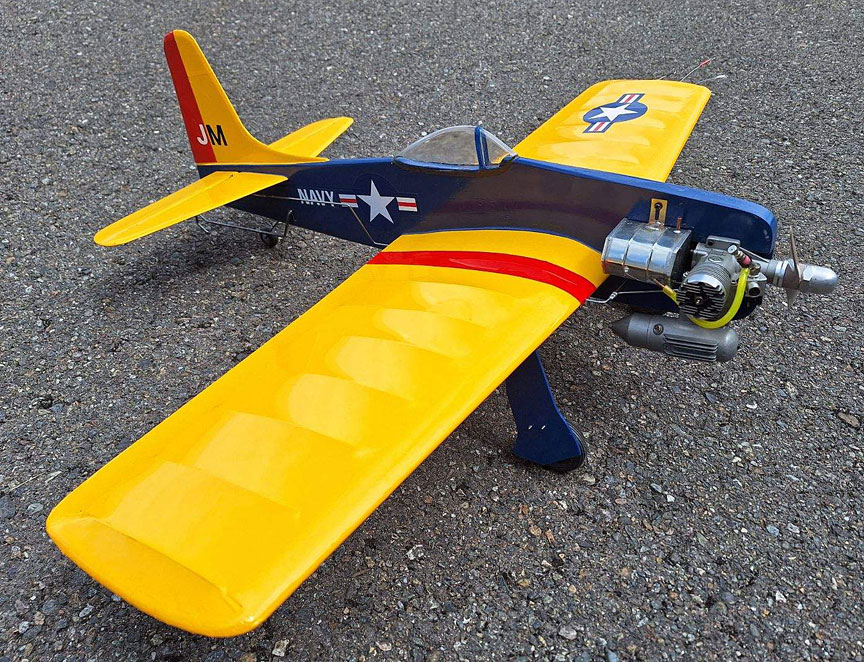
Jim McCartney of Lake Tapps, Wash., recently built this Brodak F8F, powered by a Tower .40, for Northwest Sport 40 Navy Carrier. The plane is done in target tug colors using Monokote and brushed-on auto paint. Mike Potter photo.
Darkow/Potter Otto the Gyro
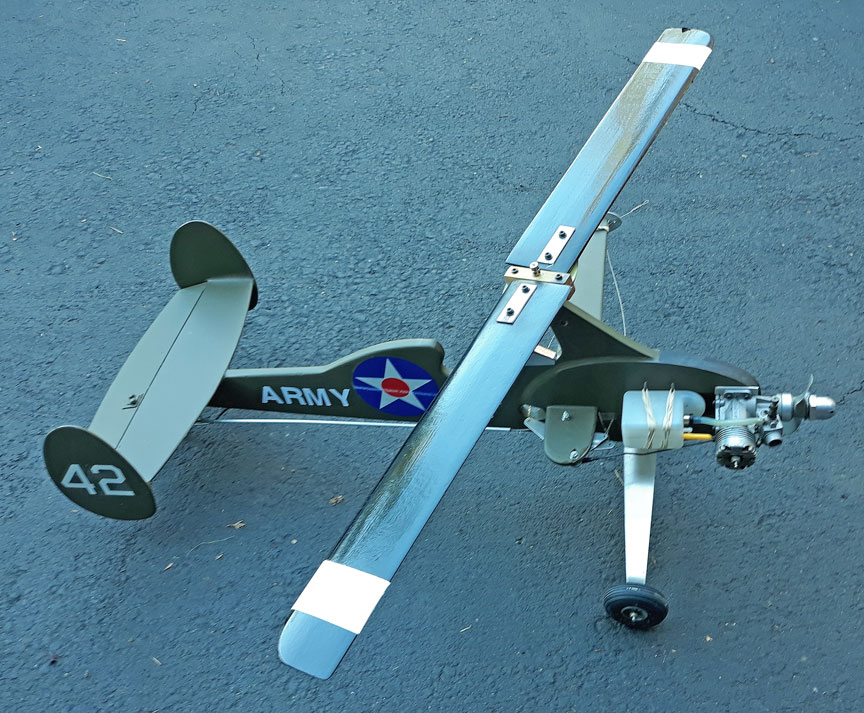
Mike Potter of Auburn, Wash., recently refinished this Otto the Gyro, built by the late Bill Darkow, in Army colors. The plane is powered by a Fox .36 reverse rotation with a OS 4BK carb. Darkow was a proponent of use of autogyros in Navy Carrier. Mike Potter photo.
Tim Wescott's Ercoupe

Tim Wescott of Oregon City, Ore., showed off this Ercoupe 415-C at the 2023 Lucky Hand Fun Fly in Salem, Ore. It is based on an Aero-Pac from Airborne Media, built from three-views in 2 inches to the foot scale, so it comes out to 60-inch wingspan, and weighs about 54 oz. Power is a Tower .40. It's flown on two lines, using a Hobby King RC car radio for throttle. Tim says: " The canopy was molded by Zirolli Models, from a plug I made. This is based on a writeup in Orin Humphries' Scale column about vacuum forming. If anyone asks, I want to assure them that the vacuum form process will reproduce your screw-ups to a far greater degree than you would think -- so you should actually pay attention to what Orin says about prepping the plug." Flying Lines photo.
Ronei Lucca's Pathfinder
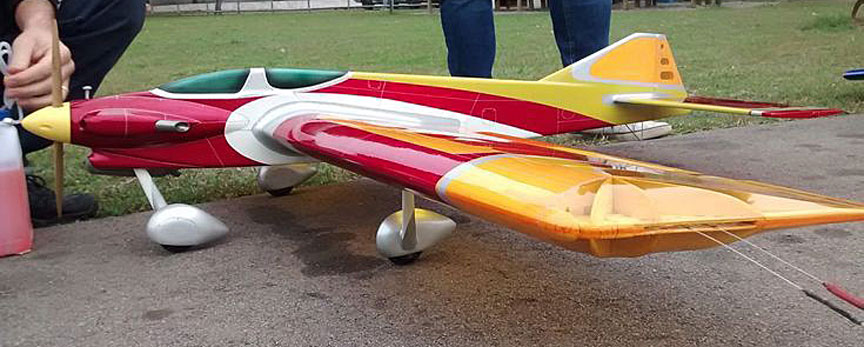
Here's another recent submission by Flying Lines reader Ronei Lucca of São Paulo, Brazil. The plane is a Pathfunder powered by an O.S. Max .40. Ronei Lucca photo.
Ronei Lucca's Team Racer

Flying Lines reader Ronei Lucca of São Paulo, Brazil, sent in photos of this Aeromodelo Recruta Team Racer powered by a CB .25. Beautiful rendition of an unusual airplane subject. Ronei Lucca photo.
Fred Cesquim's Hellcat

This Hellcat is a Precision Aerobatics plane from regular Flying Lines contributor Frederico Cesquim of São Paulo, Brazil. Fred describes the project: "Final weight is 1,890 grams with battery (66.6 oz., approximately). Dead straight from the building board! So far my best pattern plane to this day. This project is based on the Kaz Minato Hellcat project tailored for F2B competition despite the scale look. I have modified the lines slightly to have a more scale appeal here and there but the 'numbers' are identical to Mr. Minato's plan. All built-up structure, fully sheeted wings, fuselage built in two separate shells and glued together for better alignment. Finish is doped silkspan on flying surfaces and carbon veil doped on fuselage. Custom made clear canopy, 3D printed pilot and fiberglass cowl. Landing gear 'scale' strut covers by Robart. Auto lacquer painted freehand, masked painted insígnias, ink lines and weathered with airbrush with a final satin clear coat for protection." Fred Cesquim photo.
Jerry Eichten's electric profile
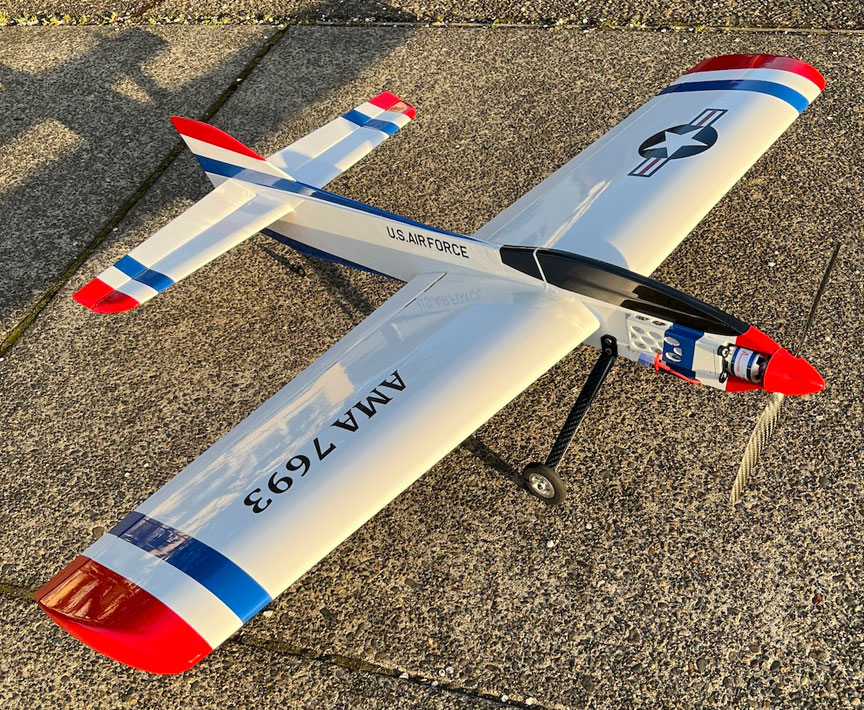
Jerry Eichten of Newberg, Ore., built this fun-flier profile with a Vector 40 wing and a Crossfire Extreme-influenced fuselage and tail fin. Weight is 39 oz. with an Arrowind 2820/07 electric motor and Thunder Power Prolite 4-cell 2800 battery. Jerry Eichten photo.
Gary Weems' Vector 40
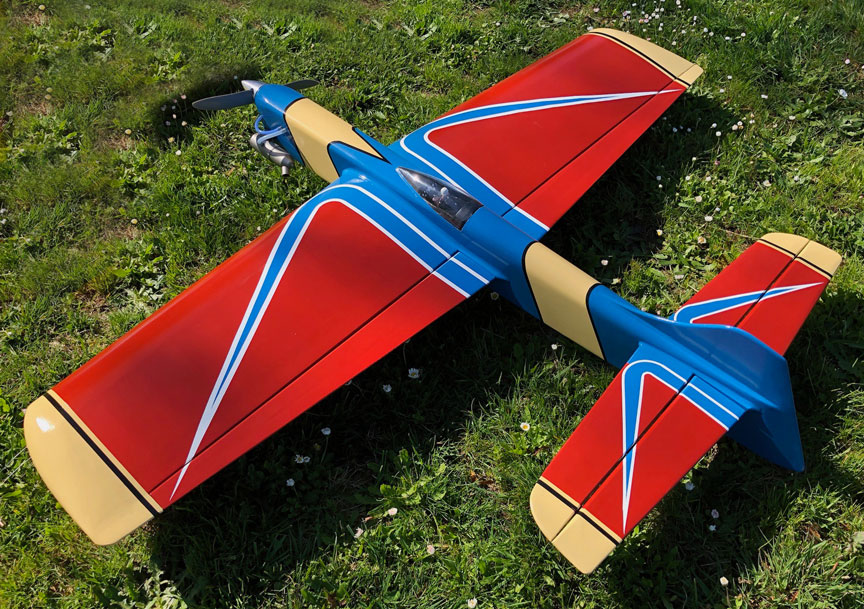
Gary Weems of Alpine, Ore., made maiden flights on this Vector 40 at the Eugene Prop Spinners' flying session at Orchard Point Park in Lane County, Ore., on April 29, 2023. Power is a Brodak .40. Flying Lines photo.
Terry Mitchell's Twin Mustang
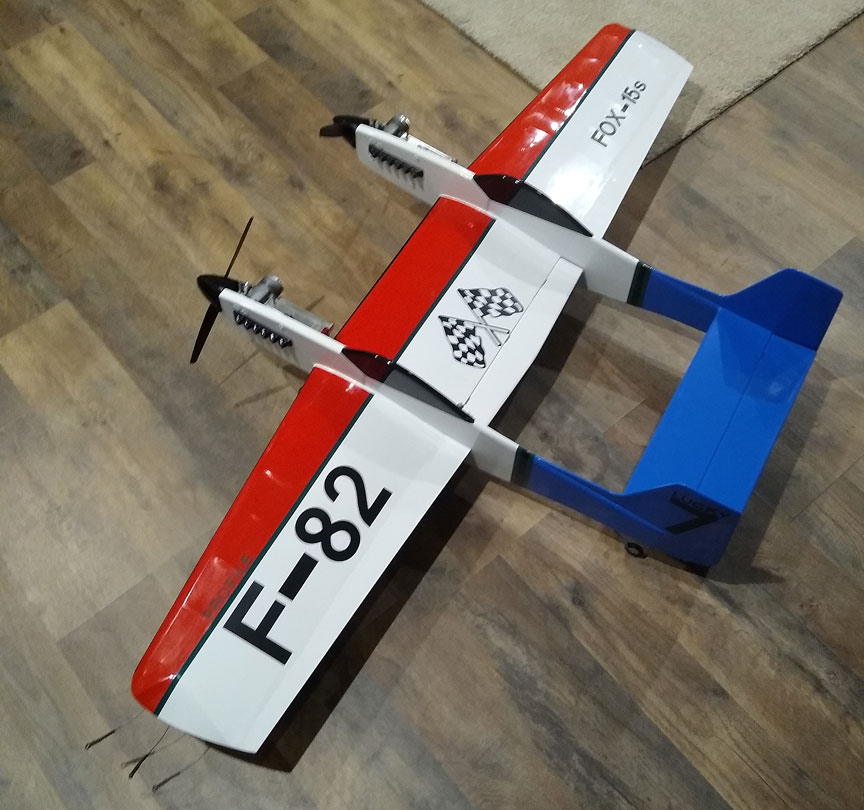
Terry Mitchell of Winston, Ore., finished this twin Mustang powered by two Fox .15 engines. John Hall started the construction some years ago. Terry finished the plane with Rustoleum paint and Monokote. Final weight is 34 oz. Terry Mitchell photo.
Andrew Liberatiscioli's Mustang
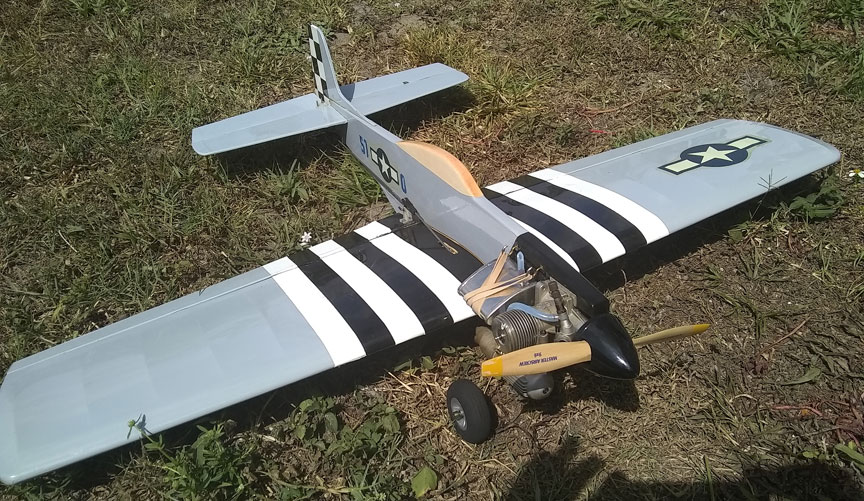
Flying Lines reader Andrew Liberatiscioli of Port Charlotte, Fla., has recently been restoring old control-line airplanes recieved from the estate of a control-line modeler who has died. This Mustang, powered by a Thunder Tiger GP .28, was in rough shape when Andrew acquired it. Andrew Liberatiscioli photo.
Ken Burdick's Wow!
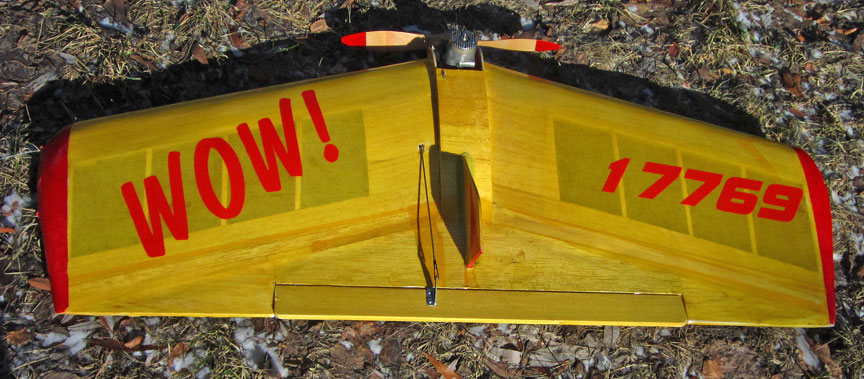
Two additions to the Northwest's growing stable of vintage Combat planes are these two builds of the Wow! design from the late 1950s. The top one is by Ken Burdick of Kamloops, B.C., powered by a Fox .29 from approximately 1960. Ken Burdick photo.
Gene Pape's Wow!
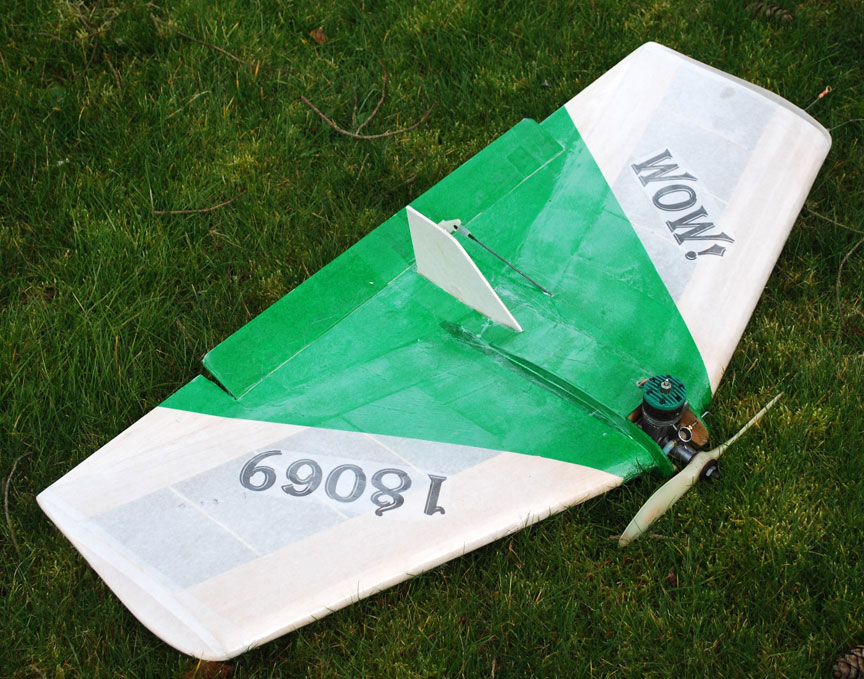
This Wow! was built by Gene Pape of Eugene, Ore., and powered by a K&B Greenhead .29S. Gene Pape photo.
Paul Walker's Impact XLv3

This is the 2023 version of the Impact by Paul Walker of Deer Park, Wash, destined for the Precision Aerobatics contests in the upcoming season. The plane has a wing area of 710 square inches and weighs 63 oz. Finish is Randolph dope. Power is a BadAss 3531-70 electric motor with 6S 2800 Li-ion battery. Paul Walker photo.
Fred Cesquim's Holeshot Master
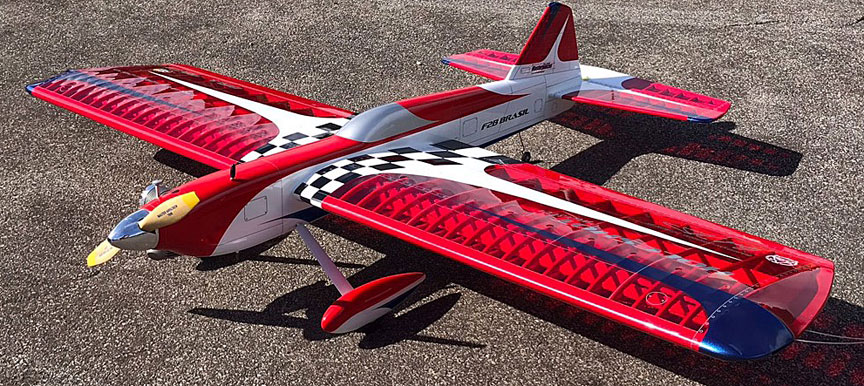
Regular Flying Lines
contributor Frederico
Cesquim of São Paulo, Brazil, built this
original-design Stunt plane based on Bob Hun't profile
Hole Shot. Fred calls it the Holeshot Master. Fred tells
the story:
"At the end of 2017 I envisioned a challenge to make
modelers interested in building and flying again and the
goal was to build and fly one chosen plane within a
period of time. Since Bob Hunt is a GREAT person and
modeller, we decided to pay homage to him as a mean to
say thanks for all of his contributions to this hobby.
His design Holeshot is very popular here, so this was
the plane to be built by contestants. The rules are
loose, so anyone could choose the engine, size, and even
change the plane a bit but retaining the Holeshot
overall look. When word reached Bob, he was happy with
the event and kindly offered a personal prize to the
winner. Unfortunately, I had to bail out due to work
when my plane was nearly on the painting stages. I
decided to make it full body. I-beam wing was chosen
because I had never built one, and it looks good. Other
mods are a bit fatter airfoil, rounded wingtips, flaps
added and about 10% area increase on wings and tail.
Engine is OS Max 35 FP. Finish is clear red Monokote,
silkspan fuselage and lacquer paint on fuse and over the
Monokote as well. Ink lines and two-part clear coat
wrapped up the project. Noteworthy is that I asked Bob
to send me his Autograph so I could paint it on the
wing. After four years I finally finished the model in
late 2021! The plane came out incredibly light (1040
grams) and flew superbly! I was so impressed with the
nice flight that decided to kit in the near future.
Let's see what 2023 brings! I already have two models
going!" Fred Cesquim photos.
Favorite Planes galleries
2022 | 2021 | 2020 | September-December 2019 |
May-August | January-April 2019 | October-December 2018 |
April-September 2018 |
January-March 2018 |
October-December 2017
| June-September 2017
| January-May 2017
| October-December
2017 | April-September
2016 | January-March
2016 | November-December
2015 | August-October
2015 | May-July
2015 | January-April
2015 | October-December
2014 | August-September
2014 | April-July
2014 | January-March
2014 | October-December
2013 | July-September
2013 | April-June
2013 | January-March
2013 | September-December
2012 | April-August
2012 | January-March
2012 | October-December
2011 | July-September
2011 | May-June
2011 | January-April
2011 | November-December
2010 | September-October
2010 | June-August
2010 | March-May
2010 | January-February
2010 | September-December
2009 | July-August
2009 | April-June
2009 | February-March
2009 | November
2008-January 2009 | September-October 2008 |
June-August 2008 |
November 2007-May 2008
| August-October 2007
| June-July 2007 |
May 2007 | March-April 2007 | January-February 2007 |
November-December 2006
| September-October
2006 | August
2006 | July 2006
| May-June 2006 |
April 2006 | March 2006 | February 2006 | January 2006
Flying
Lines home page
This page
was updated Jan. 8, 2024